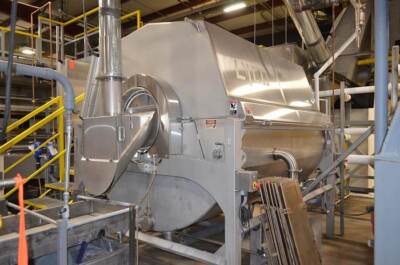Food processing equipment used worldwide is an essential component of the global food supply chain, transforming raw ingredients into consumable products. This equipment plays a crucial role in ensuring efficiency, safety, and quality in food production. From small-scale operations to large industrial facilities, various types of used processing equipment are employed to handle different processes such as washing, cutting, cooking, and packaging.
As the demand for processed foods continues to rise, understanding the food processing equipment used in this sector becomes increasingly important. This article will explore the diverse types of food processing equipment company, their features, regional variations, and the innovative technologies driving the industry forward. Additionally, we will include insights from industry professionals and examples of successful implementations.
Types of Food Processing Equipment: An Overview
Food processing equipment encompasses a vast array of machines and tools, each designed for specific tasks in the production process. Below are some of the primary categories and examples of equipment used in food processing.
1. Preparation Equipment
Preparation equipment is essential for handling raw materials before they are processed further. This category includes:
- Cutters and Slicers: Used for chopping vegetables and slicing meats. For instance, a food processing company in California reported a 30% increase in efficiency after integrating a high-speed slicer in their operations.
- Mixers: Essential for blending ingredients in baking or cooking processes, vital for consistent product quality.
- Washers: Equipment designed to clean fruits and vegetables before processing, ensuring hygiene compliance.
2. Cooking Equipment
Cooking equipment is vital for converting raw ingredients into ready-to-eat products. Key examples include:
- Ovens: Used for baking and roasting various food items, enhancing flavor and texture.
- Steamers: Ideal for cooking vegetables or seafood while preserving nutrients, a technique widely adopted in health-conscious food brands.
- Fryers: Commonly used in the fast-food industry for frying foods quickly and evenly, with innovations leading to healthier frying options.
3. Cooling and Freezing Equipment
To preserve food quality and safety, cooling and freezing equipment is necessary. This includes:
- Refrigerators: Used for storing perishable items at safe temperatures, critical for compliance with food safety regulations.
- Blast Freezers: Rapidly freeze food items to maintain texture and flavor, utilized by many food processing companies to extend shelf life.
- Chillers: Designed for cooling freshly cooked meals before packaging, ensuring optimal temperature control.
4. Packaging Equipment
Packaging is the final step in the food processing chain, critical for extending shelf life and ensuring safety. Common packaging equipment includes:
- Filling Machines: Used for portioning liquids and solids into containers, enhancing productivity.
- Sealers: Essential for sealing packages to prevent contamination, an area where many food processing companies invest heavily.
- Labeling Machines: Automated systems for applying labels to products, facilitating compliance with labeling regulations.
5. Cleaning and Sanitizing Equipment
Maintaining hygiene in food processing is paramount. Equipment in this category includes:
- Pressure Washers: For cleaning surfaces and equipment, improving sanitation protocols.
- Sanitizing Systems: Automated systems for ensuring equipment is free from pathogens, a critical aspect of food safety.
Understanding the various types of food processing equipment used is crucial for businesses aiming to optimize their production processes and meet regulatory standards.
Key Features of Modern Food Processing Equipment
Modern food processing equipment has evolved significantly, incorporating advanced technologies and features that enhance efficiency and safety. Here are some key characteristics of contemporary equipment:
1. Automation and Control Systems
Automation is transforming the food processing industry by reducing labor costs and increasing precision. Many modern machines come equipped with:
- Programmable Logic Controllers (PLCs): Allowing operators to set specific parameters for processing.
- Touchscreen Interfaces: Making it easier to monitor and adjust settings in real-time.
2. Energy Efficiency
With rising energy costs and environmental concerns, energy-efficient processing equipment is gaining importance. Key features include:
- Variable Frequency Drives (VFDs): Adjust motor speed based on demand, reducing energy consumption.
- Insulation Technologies: Minimizing heat loss in cooking and cooling equipment.
3. Safety Features
Safety is paramount in food processing. Modern equipment includes several safety features such as:
- Emergency Stop Buttons: Allowing for immediate shutdown in case of an emergency.
- Safety Guards: Protecting operators from moving parts and potential hazards.
4. Versatility
Many modern machines are designed to handle multiple tasks, providing flexibility for food processors. Features include:
- Interchangeable Parts: Allowing equipment to switch between different functions quickly.
- Modular Designs: Enabling easy upgrades and adaptations to new processing requirements.
5. Data Monitoring and Analytics
With the rise of the Internet of Things (IoT), food processing equipment can now collect and analyze data. This feature offers:
- Real-time Performance Monitoring: Helping operators identify bottlenecks and inefficiencies.
- Predictive Maintenance: Allowing for timely repairs and reducing downtime.
Investing in modern food processing equipment not only improves productivity but also enhances product quality and safety, making it a vital component for any food processing company.

Regional Variations in Food Processing Techniques
Food processing techniques can vary significantly across different regions of the world, influenced by local cultures, climates, and available resources. Understanding these regional variations can provide valuable insights into global food trends.
1. North America
In North America, food processing is highly industrialized, focusing on efficiency and scalability. Key characteristics include:
- Advanced Automation: Many facilities employ robotics for tasks such as packaging and palletizing.
- Emphasis on Convenience Foods: There is a growing demand for ready-to-eat meals and snacks, driving innovation in packaging and preservation technologies.
2. Europe
European food processing emphasizes quality and sustainability. Notable trends include:
- Organic Processing: A significant rise in the processing of organic foods, requiring specialized equipment to maintain product integrity.
- Artisanal Techniques: Many regions still use traditional methods for processing, particularly in cheese and charcuterie production.
3. Asia
Asia boasts a diverse range of food processing techniques, often influenced by local culinary traditions. Important aspects include:
- Fermentation: Techniques for producing fermented foods like kimchi and soy sauce are prevalent and require specific equipment for controlled fermentation.
- Street Food Culture: The processing of street foods often involves mobile equipment that can be easily transported and set up.
4. Latin America
Latin America’s food processing sector is characterized by a strong focus on local ingredients and flavors. Key features include:
- Traditional Methods: Many processes still rely on hand-crafted techniques, particularly in rural areas.
- Emerging Technologies: While traditional methods are common, there is a growing interest in adopting modern processing technologies to increase efficiency.
Understanding these regional variations helps food processing companies tailor their equipment and processes to meet local demands and preferences.
Innovative Technologies in Food Processing Equipment
The food processing industry is at the forefront of technological innovation, with advancements that improve efficiency, safety, and product quality. Here are some of the latest technologies shaping the sector:
1. Smart Sensors and IoT Devices
Smart sensors and Internet of Things (IoT) devices are revolutionizing food processing by enabling real-time monitoring and control. Benefits include:
- Temperature and Humidity Monitoring: Ensuring optimal conditions for food preservation.
- Remote Access: Allowing operators to manage equipment from anywhere, enhancing flexibility.
2. Robotics and Automation
Robotic technology is increasingly being integrated into food processing lines. Key advantages include:
- Increased Precision: Robots can perform repetitive tasks with high accuracy, reducing waste.
- Labor Shortages: Automation addresses the challenges posed by labor shortages in the industry.
3. 3D Food Printing
3D food printing is an emerging technology that allows for the creation of complex food shapes and textures. This innovation offers:
- Customization: Tailoring food products to meet specific dietary needs or preferences.
- Sustainability: Utilizing alternative ingredients and reducing food waste by using only what is necessary.
4. Advanced Preservation Techniques
New preservation methods, such as high-pressure processing (HPP) and pulsed electric fields (PEF), are gaining popularity. These techniques provide:
- Extended Shelf Life: Minimizing the need for preservatives while maintaining flavor and nutrients.
- Food Safety: Reducing pathogens and spoilage organisms without compromising quality.
5. Blockchain Technology
Blockchain technology is being adopted in food processing for traceability and transparency. Key benefits include:
- Supply Chain Transparency: Allowing consumers to trace the origin of their food products.
- Quality Assurance: Ensuring that food safety standards are met throughout the supply chain.
These innovative technologies not only enhance food processing efficiency but also contribute to improved food safety and consumer confidence.
Sustainability Trends in Food Processing Equipment Used Today
Sustainability has become a critical focus in the food processing industry, with companies increasingly seeking ways to reduce their environmental impact. Here are some prominent sustainability trends in food processing equipment:
1. Energy-Efficient Machinery
The shift towards energy-efficient machinery is essential for reducing operational costs and minimizing carbon footprints. Features include:
- Energy Star Ratings: Equipment that meets energy efficiency guidelines set by environmental agencies.
- Renewable Energy Integration: Many facilities are now using solar and wind energy to power their operations.
2. Waste Reduction Technologies
Innovative technologies aimed at reducing waste are gaining traction in the food processing sector, such as:
- Closed-Loop Systems: These systems recycle water and materials, minimizing waste generation.
- Byproduct Utilization: Equipment designed to convert food waste into valuable byproducts, such as animal feed or bioenergy.
3. Sustainable Packaging Solutions
Sustainable packaging is becoming a key consideration for food processors. Trends include:
- Biodegradable Materials: Using packaging that breaks down naturally to reduce landfill waste.
- Minimalist Packaging: Reducing packaging size and materials to lessen environmental impact.
4. Water Conservation Practices
Water is a precious resource in food processing, and companies are implementing conservation measures such as:
- Water Recycling Systems: Technologies that purify and reuse water in processing.
- Efficient Cleaning Processes: Equipment designed to minimize water usage during cleaning operations.
5. Eco-Friendly Production Processes
Many food processing companies are adopting eco-friendly production methods, including:
- Organic Processing: Utilizing organic ingredients and methods that reduce chemical use.
- Local Sourcing: Reducing transportation emissions by sourcing ingredients locally whenever possible.
By prioritizing sustainability, food processing companies can not only comply with regulatory requirements but also appeal to environmentally conscious consumers.
Maintenance and Safety Practices for Food Processing Equipment
Maintaining food processing equipment is crucial for ensuring safety, efficiency, and product quality. Here are key maintenance and safety practices:
1. Regular Inspections and Maintenance
Routine inspections and maintenance are vital for preventing equipment failures. Key practices include:
- Scheduled Maintenance: Implementing a regular maintenance schedule based on manufacturer recommendations.
- Detailed Log Keeping: Maintaining logs of inspections, repairs, and maintenance activities for accountability.
2. Operator Training
Training operators on proper equipment use ensures safety and efficiency. Important training aspects include:
- Safety Procedures: Teaching operators emergency protocols and safety practices.
- Equipment Operation: Providing detailed training on the specific equipment they will operate.
3. Hygiene and Sanitation Protocols
Maintaining hygiene is paramount in food processing. Key protocols include:
- Cleaning Schedules: Establishing regular cleaning routines for all equipment.
- Sanitization Practices: Ensuring that all surfaces and equipment are sanitized to prevent contamination.
4. Emergency Preparedness
Having a comprehensive emergency preparedness plan is essential for handling accidents. Key components include:
- Emergency Contacts: Maintaining a list of emergency contacts, including local authorities and medical facilities.
- Drills and Training: Conducting regular drills to ensure all staff are prepared for emergencies.
5. Compliance with Regulations
Compliance with industry regulations is critical for food safety. Key practices include:
- Regular Audits: Conducting internal and external audits to ensure adherence to safety standards.
- Documentation: Keeping thorough records of all compliance-related activities and inspections.
Implementing these maintenance and safety practices not only protects the workforce but also enhances the overall quality and safety of food products.
Future Trends: The Evolution of Food Processing Equipment Worldwide
The food processing industry is continuously evolving, driven by technological advancements and changing consumer preferences. Here are some future trends that are likely to shape food processing equipment:
1. Increased Automation
As labor costs rise and technology advances, the trend towards increased automation will continue. Key aspects include:
- AI Integration: Artificial intelligence will play a more significant role in optimizing processing lines and predictive maintenance.
- Collaborative Robots (Cobots): These robots will work alongside human operators to enhance productivity and safety.
2. Personalized Nutrition
The growing demand for personalized nutrition will lead to changes in food processing equipment. Key developments include:
- Customizable Production Lines: Equipment capable of producing tailored food products based on individual dietary needs.
- Data-Driven Processing: Utilizing consumer data to adjust production processes for specific health trends.
3. Enhanced Food Safety Technologies
Food safety will remain a top priority, prompting innovations such as:
- Blockchain for Traceability: Greater adoption of blockchain technology will enhance transparency and traceability in food sourcing.
- Advanced Detection Systems: Improved sensors for detecting contaminants and pathogens in real-time.
4. Sustainable Practices
The push for sustainability will continue to influence food processing equipment. Key trends include:
- Zero-Waste Technologies: Innovations aimed at minimizing waste throughout the processing cycle.
- Circular Economy Practices: Equipment designed to facilitate recycling and sustainable sourcing of materials.
5. Globalization of Food Processing
As global trade continues to expand, food processing companies will need to adapt to diverse markets. Key factors include:
- Localization of Production: Establishing production facilities closer to key markets to reduce transportation costs and improve freshness.
- Cultural Adaptation: Modifying processing techniques and equipment to cater to local tastes and preferences.
The future of food processing equipment is bright, with exciting advancements on the horizon that promise to enhance efficiency, sustainability, and product quality.
In conclusion, the world of food processing equipment used is vast and continually evolving. From understanding the various types of equipment used to recognizing the importance of sustainability and safety, it’s clear that these machines play a vital role in the food supply chain. Personal experiences and case studies from industry professionals illustrate the impact of modern equipment on productivity and safety. As technology advances and consumer preferences shift, the food processing industry will adapt, ensuring that we have access to safe, high-quality food products. Whether you are part of a food processing company or simply interested in the field, staying informed about these trends and technologies will be essential for success in the future.
| Future Trend | Description | Implications for Industry |
| Increased Automation | Adoption of AI and collaborative robots in processing lines for enhanced productivity. | Reduced labor costs and increased efficiency in food production processes. |
| Personalized Nutrition | Development of customizable production lines to meet individual dietary needs. | Greater consumer satisfaction and potential for niche markets in food products. |
| Enhanced Food Safety Technologies | Implementation of blockchain for traceability and advanced detection systems for contaminants. | Improved compliance with safety standards and increased consumer trust. |
| Sustainable Practices | Adoption of zero-waste technologies and circular economy practices in food processing. | Reduction in environmental impact and improved corporate responsibility. |
| Globalization of Food Processing | Localization of production and adaptation to diverse markets and cultural preferences. | Enhanced market reach and ability to cater to global consumer demands. |
Featured client/products:
Glass Floors | Semi Truck Ramp | Glass Blocks| IT Companies Near Me | SEO Services Near Me | Steel Yard Ramp | Ramp for Loading Dock | Glass Flooring | Loading Dock Ramps | Portable Yard Ramp | Painters Near Me | Interior Painters Near Me



